Comprehensive Report on PS4 Pricing Methods and Product Costing
VerifiedAdded on 2023/01/10
|8
|1521
|80
Report
AI Summary
This report provides a detailed analysis of pricing strategies, specifically focusing on the PlayStation 4 (PS4). It begins by defining product costing and its importance in identifying expenses related to creating goods and services. The report then explores two primary pricing methods: cost-plus pricing and value-based pricing. Cost-plus pricing involves adding a markup to the cost of a product, while value-based pricing centers on the perceived customer value. The relationship between product costing and these pricing methods is examined, highlighting how cost considerations influence pricing decisions. The advantages and disadvantages of each pricing strategy are discussed, providing insights into their practical application and effectiveness. The report concludes by summarizing the key findings and emphasizing the significance of product costing in the context of business development. The report uses references from various books, journals and online resources to support the findings.
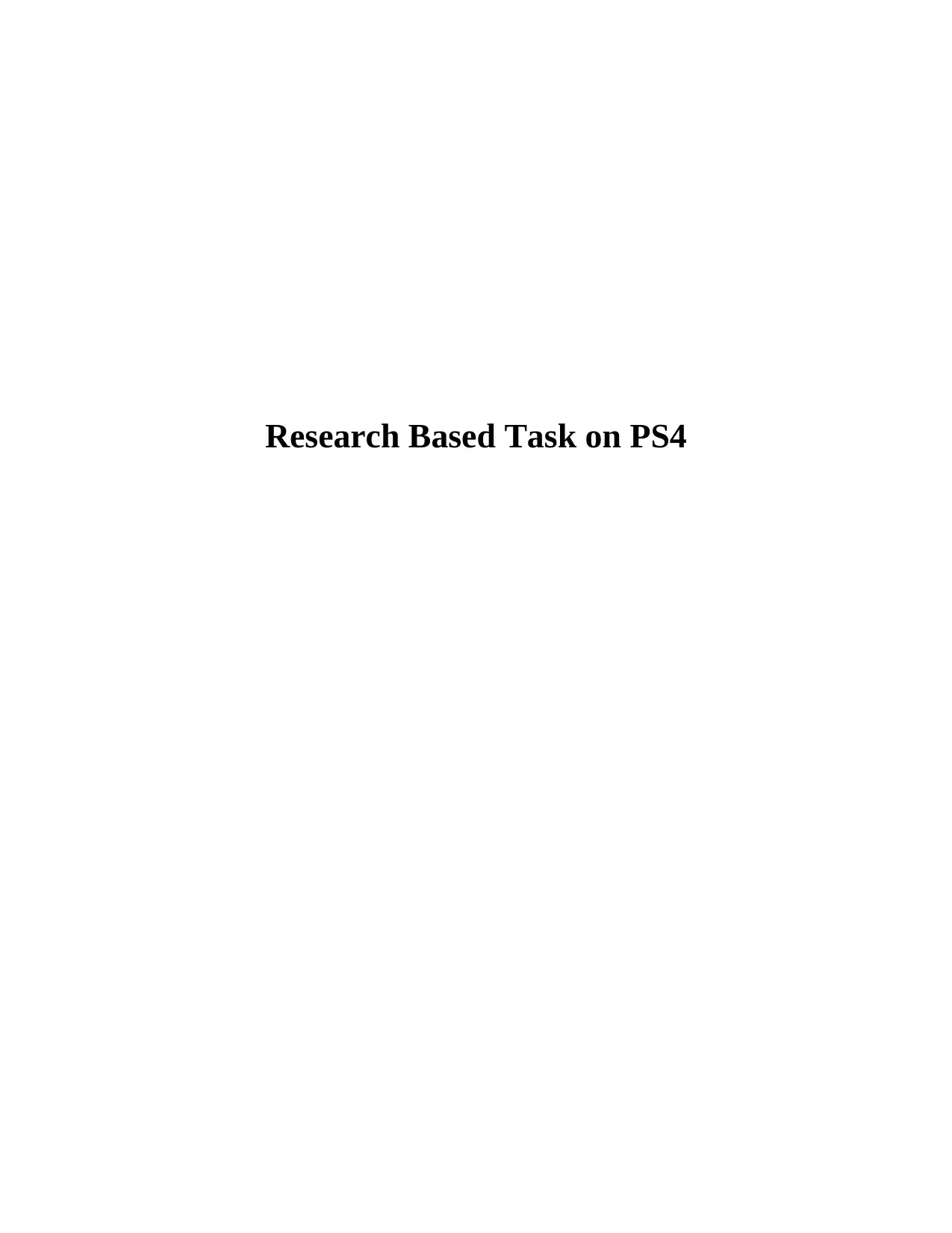
Research Based Task on PS4
Paraphrase This Document
Need a fresh take? Get an instant paraphrase of this document with our AI Paraphraser
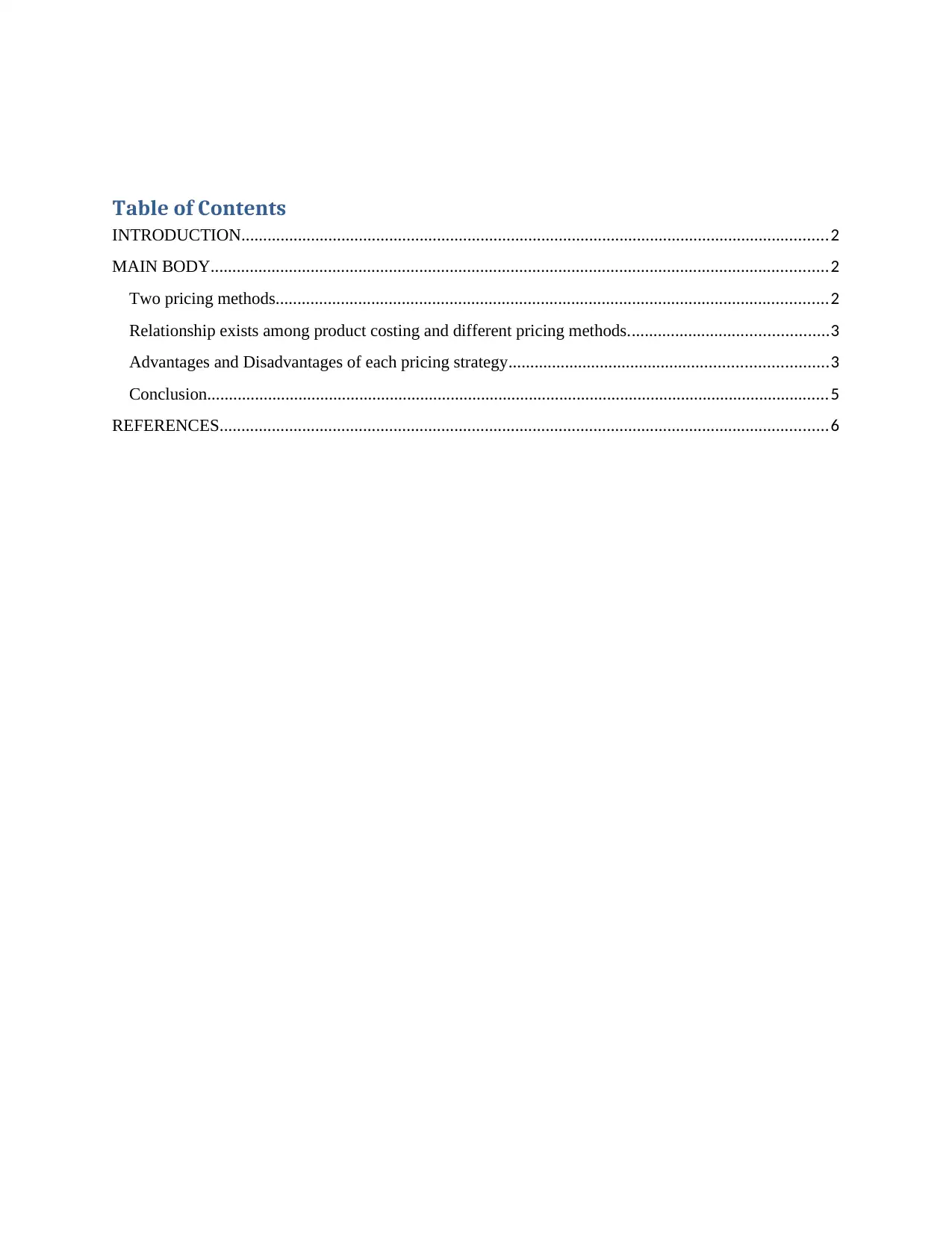
Table of Contents
INTRODUCTION.......................................................................................................................................2
MAIN BODY..............................................................................................................................................2
Two pricing methods...............................................................................................................................2
Relationship exists among product costing and different pricing methods..............................................3
Advantages and Disadvantages of each pricing strategy.........................................................................3
Conclusion...............................................................................................................................................5
REFERENCES............................................................................................................................................6
INTRODUCTION.......................................................................................................................................2
MAIN BODY..............................................................................................................................................2
Two pricing methods...............................................................................................................................2
Relationship exists among product costing and different pricing methods..............................................3
Advantages and Disadvantages of each pricing strategy.........................................................................3
Conclusion...............................................................................................................................................5
REFERENCES............................................................................................................................................6
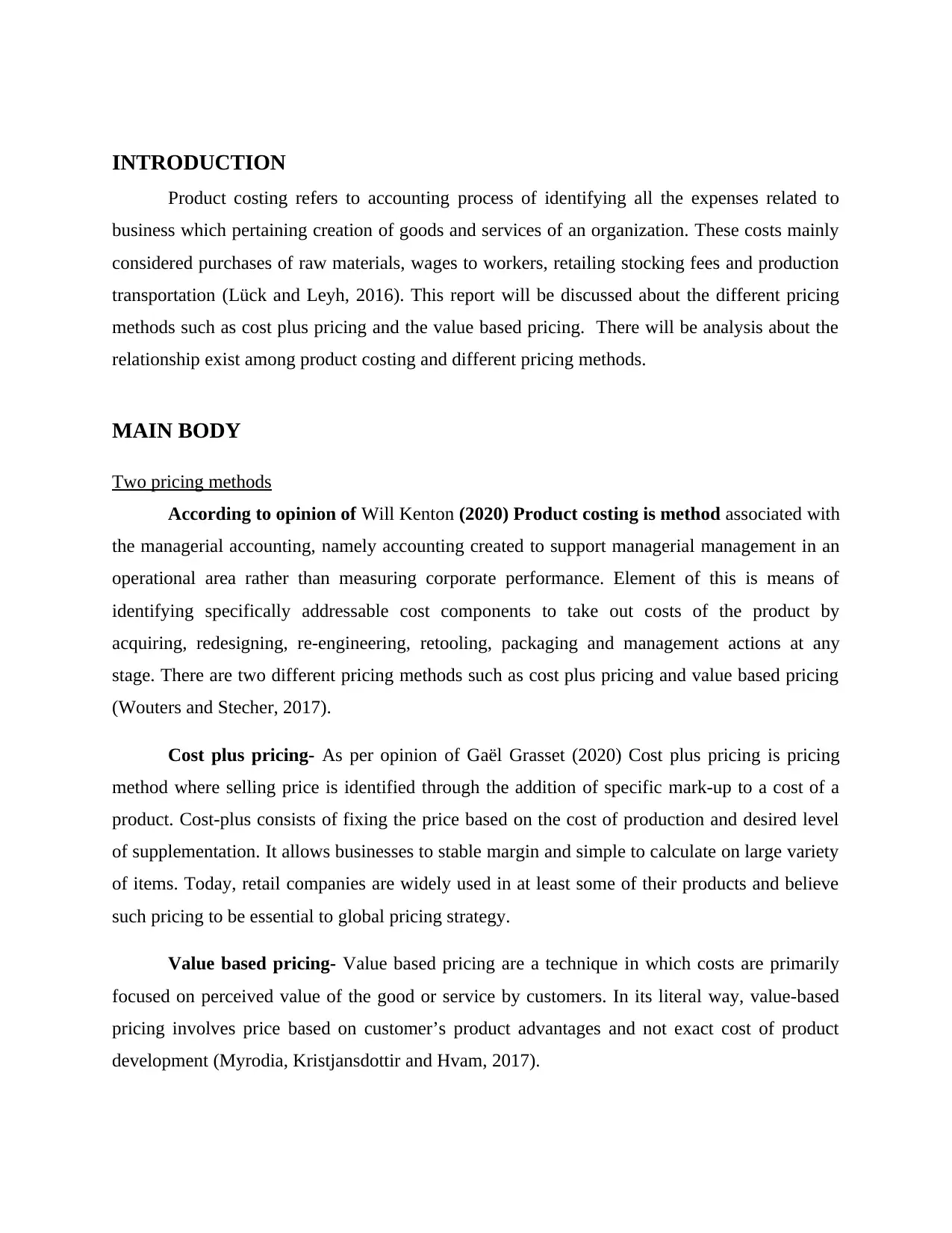
INTRODUCTION
Product costing refers to accounting process of identifying all the expenses related to
business which pertaining creation of goods and services of an organization. These costs mainly
considered purchases of raw materials, wages to workers, retailing stocking fees and production
transportation (Lück and Leyh, 2016). This report will be discussed about the different pricing
methods such as cost plus pricing and the value based pricing. There will be analysis about the
relationship exist among product costing and different pricing methods.
MAIN BODY
Two pricing methods
According to opinion of Will Kenton (2020) Product costing is method associated with
the managerial accounting, namely accounting created to support managerial management in an
operational area rather than measuring corporate performance. Element of this is means of
identifying specifically addressable cost components to take out costs of the product by
acquiring, redesigning, re-engineering, retooling, packaging and management actions at any
stage. There are two different pricing methods such as cost plus pricing and value based pricing
(Wouters and Stecher, 2017).
Cost plus pricing- As per opinion of Gaël Grasset (2020) Cost plus pricing is pricing
method where selling price is identified through the addition of specific mark-up to a cost of a
product. Cost-plus consists of fixing the price based on the cost of production and desired level
of supplementation. It allows businesses to stable margin and simple to calculate on large variety
of items. Today, retail companies are widely used in at least some of their products and believe
such pricing to be essential to global pricing strategy.
Value based pricing- Value based pricing are a technique in which costs are primarily
focused on perceived value of the good or service by customers. In its literal way, value-based
pricing involves price based on customer’s product advantages and not exact cost of product
development (Myrodia, Kristjansdottir and Hvam, 2017).
Product costing refers to accounting process of identifying all the expenses related to
business which pertaining creation of goods and services of an organization. These costs mainly
considered purchases of raw materials, wages to workers, retailing stocking fees and production
transportation (Lück and Leyh, 2016). This report will be discussed about the different pricing
methods such as cost plus pricing and the value based pricing. There will be analysis about the
relationship exist among product costing and different pricing methods.
MAIN BODY
Two pricing methods
According to opinion of Will Kenton (2020) Product costing is method associated with
the managerial accounting, namely accounting created to support managerial management in an
operational area rather than measuring corporate performance. Element of this is means of
identifying specifically addressable cost components to take out costs of the product by
acquiring, redesigning, re-engineering, retooling, packaging and management actions at any
stage. There are two different pricing methods such as cost plus pricing and value based pricing
(Wouters and Stecher, 2017).
Cost plus pricing- As per opinion of Gaël Grasset (2020) Cost plus pricing is pricing
method where selling price is identified through the addition of specific mark-up to a cost of a
product. Cost-plus consists of fixing the price based on the cost of production and desired level
of supplementation. It allows businesses to stable margin and simple to calculate on large variety
of items. Today, retail companies are widely used in at least some of their products and believe
such pricing to be essential to global pricing strategy.
Value based pricing- Value based pricing are a technique in which costs are primarily
focused on perceived value of the good or service by customers. In its literal way, value-based
pricing involves price based on customer’s product advantages and not exact cost of product
development (Myrodia, Kristjansdottir and Hvam, 2017).
You're viewing a preview
Unlock full access by subscribing today!
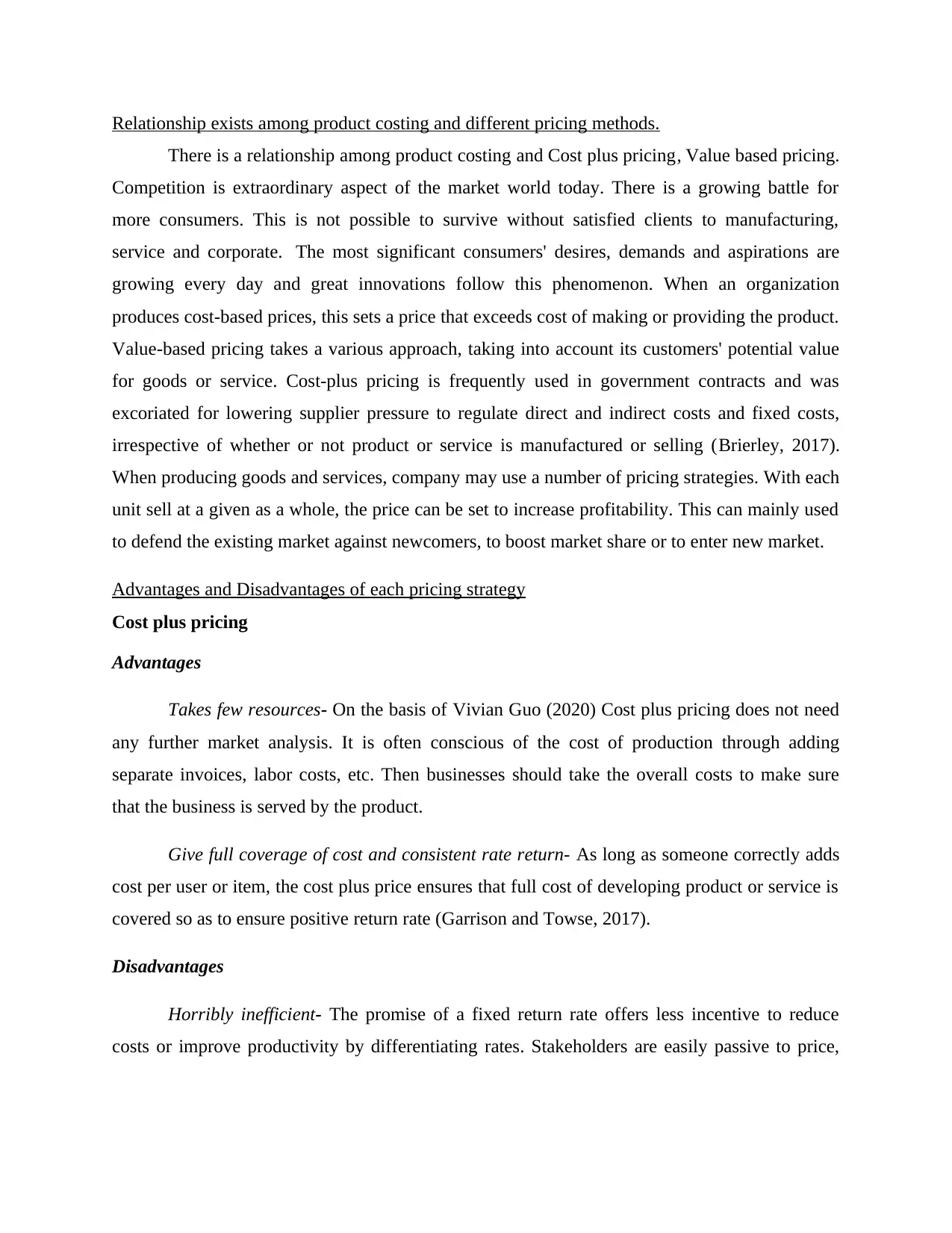
Relationship exists among product costing and different pricing methods.
There is a relationship among product costing and Cost plus pricing, Value based pricing.
Competition is extraordinary aspect of the market world today. There is a growing battle for
more consumers. This is not possible to survive without satisfied clients to manufacturing,
service and corporate. The most significant consumers' desires, demands and aspirations are
growing every day and great innovations follow this phenomenon. When an organization
produces cost-based prices, this sets a price that exceeds cost of making or providing the product.
Value-based pricing takes a various approach, taking into account its customers' potential value
for goods or service. Cost-plus pricing is frequently used in government contracts and was
excoriated for lowering supplier pressure to regulate direct and indirect costs and fixed costs,
irrespective of whether or not product or service is manufactured or selling (Brierley, 2017).
When producing goods and services, company may use a number of pricing strategies. With each
unit sell at a given as a whole, the price can be set to increase profitability. This can mainly used
to defend the existing market against newcomers, to boost market share or to enter new market.
Advantages and Disadvantages of each pricing strategy
Cost plus pricing
Advantages
Takes few resources- On the basis of Vivian Guo (2020) Cost plus pricing does not need
any further market analysis. It is often conscious of the cost of production through adding
separate invoices, labor costs, etc. Then businesses should take the overall costs to make sure
that the business is served by the product.
Give full coverage of cost and consistent rate return- As long as someone correctly adds
cost per user or item, the cost plus price ensures that full cost of developing product or service is
covered so as to ensure positive return rate (Garrison and Towse, 2017).
Disadvantages
Horribly inefficient- The promise of a fixed return rate offers less incentive to reduce
costs or improve productivity by differentiating rates. Stakeholders are easily passive to price,
There is a relationship among product costing and Cost plus pricing, Value based pricing.
Competition is extraordinary aspect of the market world today. There is a growing battle for
more consumers. This is not possible to survive without satisfied clients to manufacturing,
service and corporate. The most significant consumers' desires, demands and aspirations are
growing every day and great innovations follow this phenomenon. When an organization
produces cost-based prices, this sets a price that exceeds cost of making or providing the product.
Value-based pricing takes a various approach, taking into account its customers' potential value
for goods or service. Cost-plus pricing is frequently used in government contracts and was
excoriated for lowering supplier pressure to regulate direct and indirect costs and fixed costs,
irrespective of whether or not product or service is manufactured or selling (Brierley, 2017).
When producing goods and services, company may use a number of pricing strategies. With each
unit sell at a given as a whole, the price can be set to increase profitability. This can mainly used
to defend the existing market against newcomers, to boost market share or to enter new market.
Advantages and Disadvantages of each pricing strategy
Cost plus pricing
Advantages
Takes few resources- On the basis of Vivian Guo (2020) Cost plus pricing does not need
any further market analysis. It is often conscious of the cost of production through adding
separate invoices, labor costs, etc. Then businesses should take the overall costs to make sure
that the business is served by the product.
Give full coverage of cost and consistent rate return- As long as someone correctly adds
cost per user or item, the cost plus price ensures that full cost of developing product or service is
covered so as to ensure positive return rate (Garrison and Towse, 2017).
Disadvantages
Horribly inefficient- The promise of a fixed return rate offers less incentive to reduce
costs or improve productivity by differentiating rates. Stakeholders are easily passive to price,
Paraphrase This Document
Need a fresh take? Get an instant paraphrase of this document with our AI Paraphraser
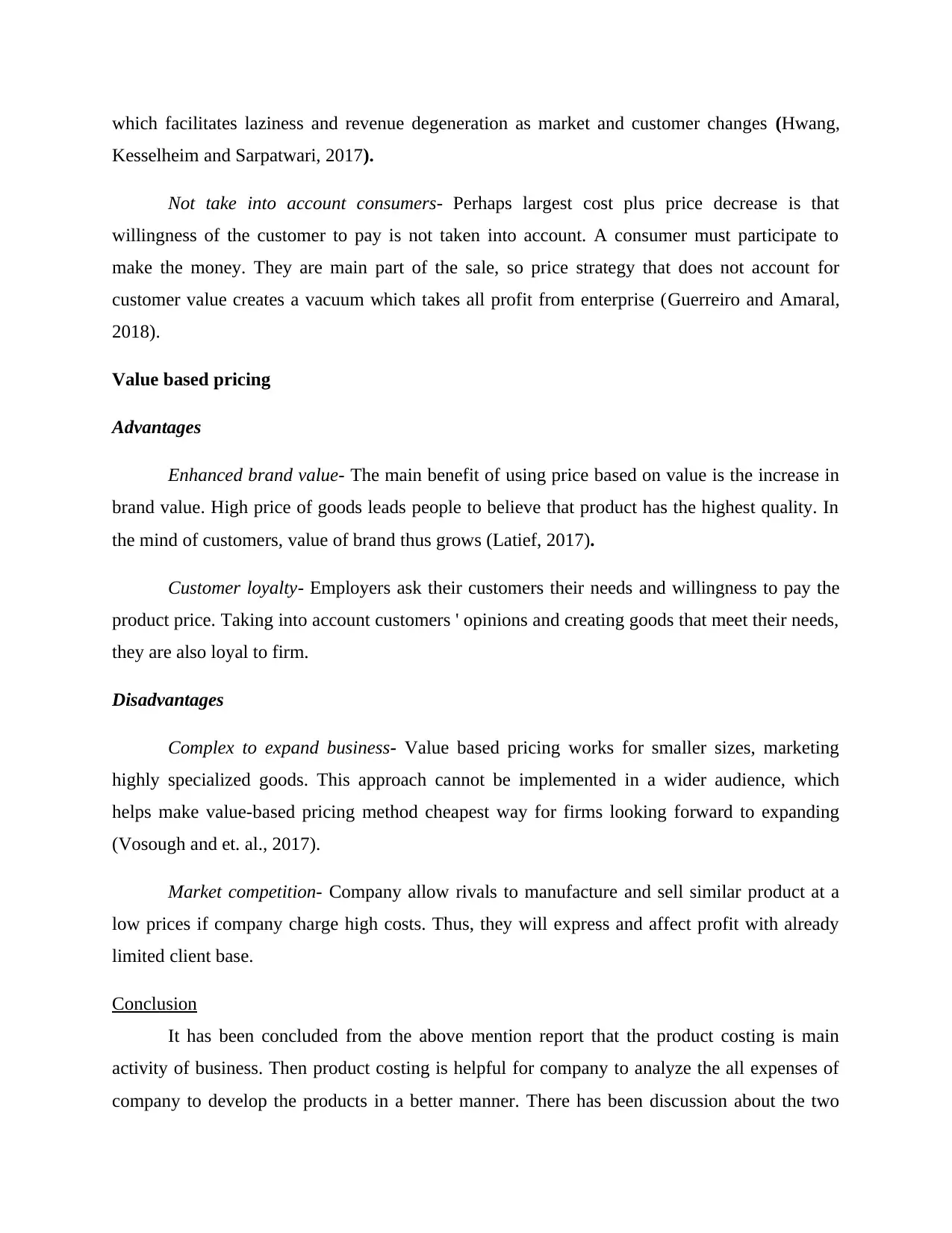
which facilitates laziness and revenue degeneration as market and customer changes (Hwang,
Kesselheim and Sarpatwari, 2017).
Not take into account consumers- Perhaps largest cost plus price decrease is that
willingness of the customer to pay is not taken into account. A consumer must participate to
make the money. They are main part of the sale, so price strategy that does not account for
customer value creates a vacuum which takes all profit from enterprise (Guerreiro and Amaral,
2018).
Value based pricing
Advantages
Enhanced brand value- The main benefit of using price based on value is the increase in
brand value. High price of goods leads people to believe that product has the highest quality. In
the mind of customers, value of brand thus grows (Latief, 2017).
Customer loyalty- Employers ask their customers their needs and willingness to pay the
product price. Taking into account customers ' opinions and creating goods that meet their needs,
they are also loyal to firm.
Disadvantages
Complex to expand business- Value based pricing works for smaller sizes, marketing
highly specialized goods. This approach cannot be implemented in a wider audience, which
helps make value-based pricing method cheapest way for firms looking forward to expanding
(Vosough and et. al., 2017).
Market competition- Company allow rivals to manufacture and sell similar product at a
low prices if company charge high costs. Thus, they will express and affect profit with already
limited client base.
Conclusion
It has been concluded from the above mention report that the product costing is main
activity of business. Then product costing is helpful for company to analyze the all expenses of
company to develop the products in a better manner. There has been discussion about the two
Kesselheim and Sarpatwari, 2017).
Not take into account consumers- Perhaps largest cost plus price decrease is that
willingness of the customer to pay is not taken into account. A consumer must participate to
make the money. They are main part of the sale, so price strategy that does not account for
customer value creates a vacuum which takes all profit from enterprise (Guerreiro and Amaral,
2018).
Value based pricing
Advantages
Enhanced brand value- The main benefit of using price based on value is the increase in
brand value. High price of goods leads people to believe that product has the highest quality. In
the mind of customers, value of brand thus grows (Latief, 2017).
Customer loyalty- Employers ask their customers their needs and willingness to pay the
product price. Taking into account customers ' opinions and creating goods that meet their needs,
they are also loyal to firm.
Disadvantages
Complex to expand business- Value based pricing works for smaller sizes, marketing
highly specialized goods. This approach cannot be implemented in a wider audience, which
helps make value-based pricing method cheapest way for firms looking forward to expanding
(Vosough and et. al., 2017).
Market competition- Company allow rivals to manufacture and sell similar product at a
low prices if company charge high costs. Thus, they will express and affect profit with already
limited client base.
Conclusion
It has been concluded from the above mention report that the product costing is main
activity of business. Then product costing is helpful for company to analyze the all expenses of
company to develop the products in a better manner. There has been discussion about the two

different pricing methods such as value based pricing and cost plus pricing in a detailed manner.
There has been also discussion about the benefits as well as the disadvantages of the both pricing
methods in an effective way.
There has been also discussion about the benefits as well as the disadvantages of the both pricing
methods in an effective way.
You're viewing a preview
Unlock full access by subscribing today!
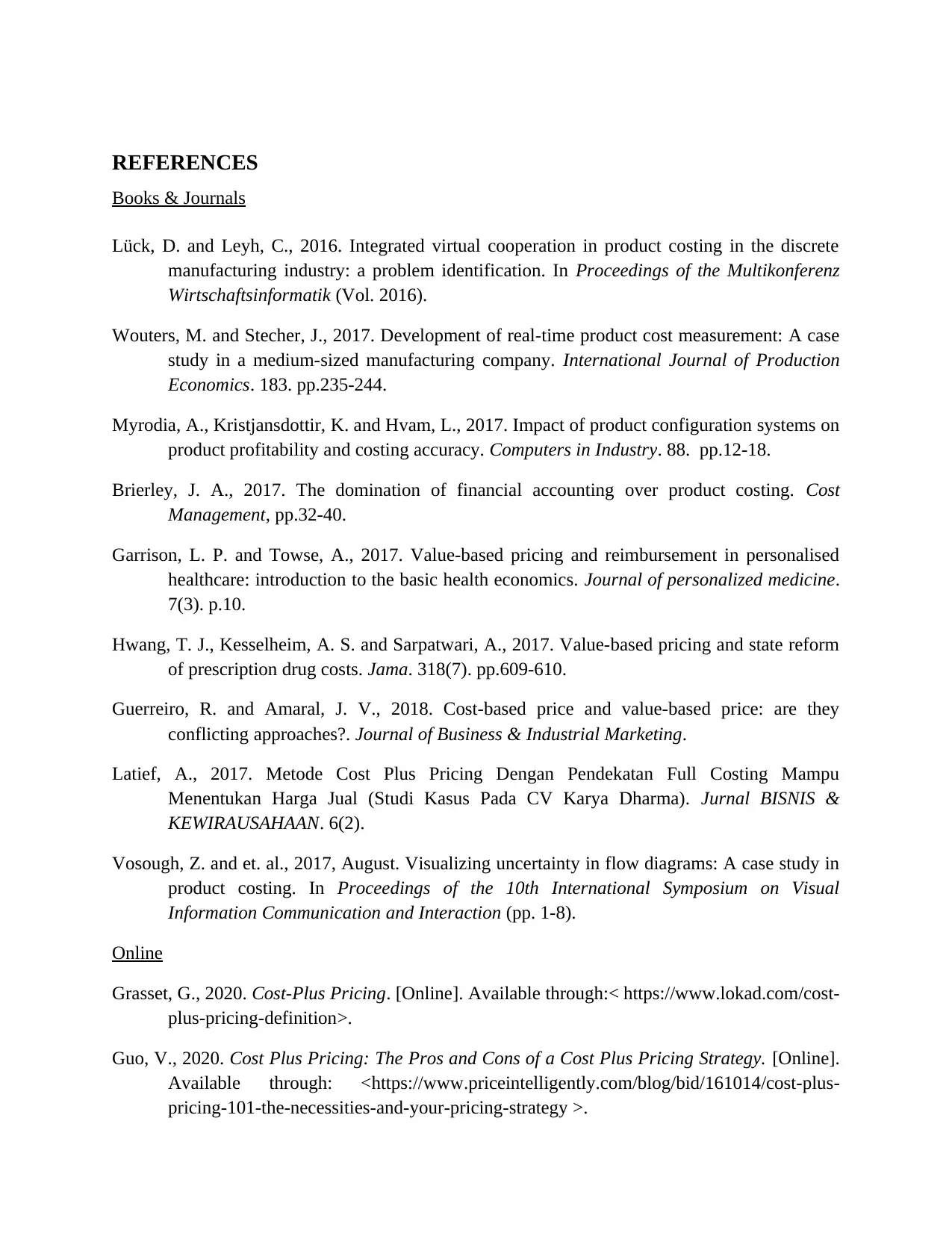
REFERENCES
Books & Journals
Lück, D. and Leyh, C., 2016. Integrated virtual cooperation in product costing in the discrete
manufacturing industry: a problem identification. In Proceedings of the Multikonferenz
Wirtschaftsinformatik (Vol. 2016).
Wouters, M. and Stecher, J., 2017. Development of real-time product cost measurement: A case
study in a medium-sized manufacturing company. International Journal of Production
Economics. 183. pp.235-244.
Myrodia, A., Kristjansdottir, K. and Hvam, L., 2017. Impact of product configuration systems on
product profitability and costing accuracy. Computers in Industry. 88. pp.12-18.
Brierley, J. A., 2017. The domination of financial accounting over product costing. Cost
Management, pp.32-40.
Garrison, L. P. and Towse, A., 2017. Value-based pricing and reimbursement in personalised
healthcare: introduction to the basic health economics. Journal of personalized medicine.
7(3). p.10.
Hwang, T. J., Kesselheim, A. S. and Sarpatwari, A., 2017. Value-based pricing and state reform
of prescription drug costs. Jama. 318(7). pp.609-610.
Guerreiro, R. and Amaral, J. V., 2018. Cost-based price and value-based price: are they
conflicting approaches?. Journal of Business & Industrial Marketing.
Latief, A., 2017. Metode Cost Plus Pricing Dengan Pendekatan Full Costing Mampu
Menentukan Harga Jual (Studi Kasus Pada CV Karya Dharma). Jurnal BISNIS &
KEWIRAUSAHAAN. 6(2).
Vosough, Z. and et. al., 2017, August. Visualizing uncertainty in flow diagrams: A case study in
product costing. In Proceedings of the 10th International Symposium on Visual
Information Communication and Interaction (pp. 1-8).
Online
Grasset, G., 2020. Cost-Plus Pricing. [Online]. Available through:< https://www.lokad.com/cost-
plus-pricing-definition>.
Guo, V., 2020. Cost Plus Pricing: The Pros and Cons of a Cost Plus Pricing Strategy. [Online].
Available through: <https://www.priceintelligently.com/blog/bid/161014/cost-plus-
pricing-101-the-necessities-and-your-pricing-strategy >.
Books & Journals
Lück, D. and Leyh, C., 2016. Integrated virtual cooperation in product costing in the discrete
manufacturing industry: a problem identification. In Proceedings of the Multikonferenz
Wirtschaftsinformatik (Vol. 2016).
Wouters, M. and Stecher, J., 2017. Development of real-time product cost measurement: A case
study in a medium-sized manufacturing company. International Journal of Production
Economics. 183. pp.235-244.
Myrodia, A., Kristjansdottir, K. and Hvam, L., 2017. Impact of product configuration systems on
product profitability and costing accuracy. Computers in Industry. 88. pp.12-18.
Brierley, J. A., 2017. The domination of financial accounting over product costing. Cost
Management, pp.32-40.
Garrison, L. P. and Towse, A., 2017. Value-based pricing and reimbursement in personalised
healthcare: introduction to the basic health economics. Journal of personalized medicine.
7(3). p.10.
Hwang, T. J., Kesselheim, A. S. and Sarpatwari, A., 2017. Value-based pricing and state reform
of prescription drug costs. Jama. 318(7). pp.609-610.
Guerreiro, R. and Amaral, J. V., 2018. Cost-based price and value-based price: are they
conflicting approaches?. Journal of Business & Industrial Marketing.
Latief, A., 2017. Metode Cost Plus Pricing Dengan Pendekatan Full Costing Mampu
Menentukan Harga Jual (Studi Kasus Pada CV Karya Dharma). Jurnal BISNIS &
KEWIRAUSAHAAN. 6(2).
Vosough, Z. and et. al., 2017, August. Visualizing uncertainty in flow diagrams: A case study in
product costing. In Proceedings of the 10th International Symposium on Visual
Information Communication and Interaction (pp. 1-8).
Online
Grasset, G., 2020. Cost-Plus Pricing. [Online]. Available through:< https://www.lokad.com/cost-
plus-pricing-definition>.
Guo, V., 2020. Cost Plus Pricing: The Pros and Cons of a Cost Plus Pricing Strategy. [Online].
Available through: <https://www.priceintelligently.com/blog/bid/161014/cost-plus-
pricing-101-the-necessities-and-your-pricing-strategy >.
Paraphrase This Document
Need a fresh take? Get an instant paraphrase of this document with our AI Paraphraser

Kenton, W., 2020. Production Costs. [Online]. Available through :<
https://www.investopedia.com/terms/p/production-cost.asp>.
https://www.investopedia.com/terms/p/production-cost.asp>.
1 out of 8
Related Documents
Your All-in-One AI-Powered Toolkit for Academic Success.
+13062052269
info@desklib.com
Available 24*7 on WhatsApp / Email
![[object Object]](/_next/static/media/star-bottom.7253800d.svg)
Unlock your academic potential
© 2024 | Zucol Services PVT LTD | All rights reserved.





